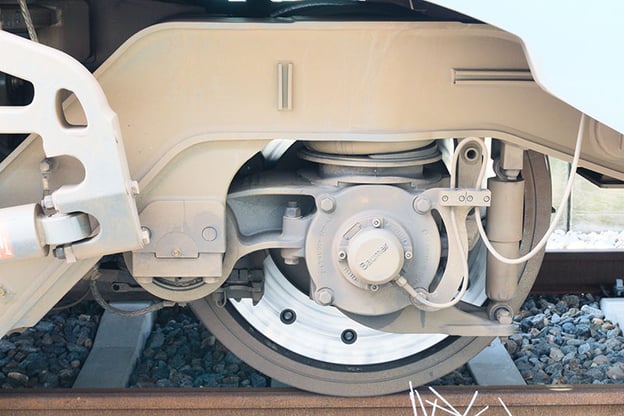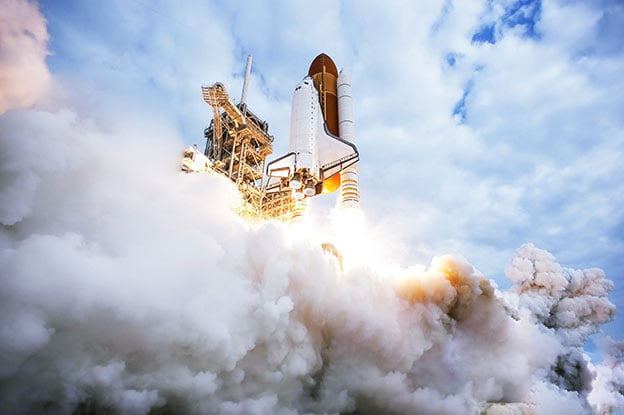5 Cool Things That Use Compressed Air Power
Compressed air is a powerful source of energy. Although most people can only list one or two everyday uses for compressed air, it’s actually abundant in the world around us. In this article, we’re going to share 5 pretty cool things that utilize compressed air as a power source—whether you can see it or not!
5. Freight & Passenger Trains

Trains are powerful machines, and Class 9 trains can reach speeds of up to 220 mph (354 km/hr). When something can move that quickly, it is critical that it can stop quickly too—and that’s where compressed air comes in.
Trains use air brakes to stop during routine operations and emergency situations. When air brakes are enabled, compressed air is used to close pads onto discs or blocks onto wheels, forcing the train to rapidly slow down.
Read more about air brakes on trains!
4. Thunder

Did you know that thunder is actually the sound of compressed air? It’s true. When a thundercloud generates lightning, the lightning bolt hits the ground and a second stroke of lightning returns to the cloud, following the exact same path. As it returns, this lighting heats the air surrounding the bolt to approximately 48,600 F (~27,000 C).
Heat forces molecules to expand but lightning occurs so quickly that the air doesn’t have enough time to expand, so it instantly becomes compressed instead. With nothing to hold those compressed particles together, the air particles then explode apart in every direction, creating the audible shock wave we all know as “thunder.”
3. Roller Coasters

Arguably the absolute most fun way to use compressed air is in a roller coaster! Many roller coasters use compressed air to create a more exhilarating experience and keep people safe. In fact, air is an excellent way to power roller coasts because it can withstand water and doesn’t require electricity.
A few of the ways roller coasters can use compressed air include:
- Launch systems
- Air brakes
- Safety gates
- Special effects
If you’re a fan of Disney’s Splash Mountain, Kingda Ka at Six Flags, or the world’s fastest roller coaster – Formula Rossa in Abu Dhabi (UAE) – then you owe thanks to the power of compressed air.
2. Snow Makers

It’s no secret that ski hills will make their own snow when the clouds don’t provide enough of it, but most people don’t realize that compressed air is behind this innovative technology.
The clouds create snow when certain conditions are met and it is fairly easy for people to recreate those conditions with a bit of clever technology. Snow makers combine water with compressed air at the desired temperature and humidity to make endless snow on demand.
Learn more about snow machines from How Stuff Works.
1. Space Shuttles & The International Space Station

Arguably one of the coolest uses of compressed air is in space shuttles and the International Space Station. NASA uses compressed air for two primary purposes:
- To launch space shuttles into space
- To sustain human life in space
During “blastoff”, space shuttles need to reach massive speeds of at least 25,000 mph to be able to escape the Earth’s atmosphere. While turbine engines do a lot of the heavy lifting, air compressors are used to increase pressure, deliver liquid hydrogen and liquid oxygen to the engine, and improve the engine’s ability to combust fuel. Air compressors help launching space shuttles burn through 500,000 gallons of liquid hydrogen and oxygen in under 8.5 minutes—the amount of time before the engine burns up completely!
Once in space, air compressors are used to sustain life. The Earth’s oxygen is made up off 78% nitrogen, 21% oxygen, and 1-2% other gasses, and this atmospheric air needs to be recreated for astronauts in space. Compressed gasses are brought to space with the shuttles and then decompressed and remixed as needed.
Compressed oxygen is mounted to the International Space Station to support life. During the preliminary years of the International Space Station, it was the only source of oxygen. NASA eventually switched to an Oxygen Generation System that mimics the splitting of molecules seen in photosynthesis, but compressed air is still available as a backup and supplemental oxygen supply.
